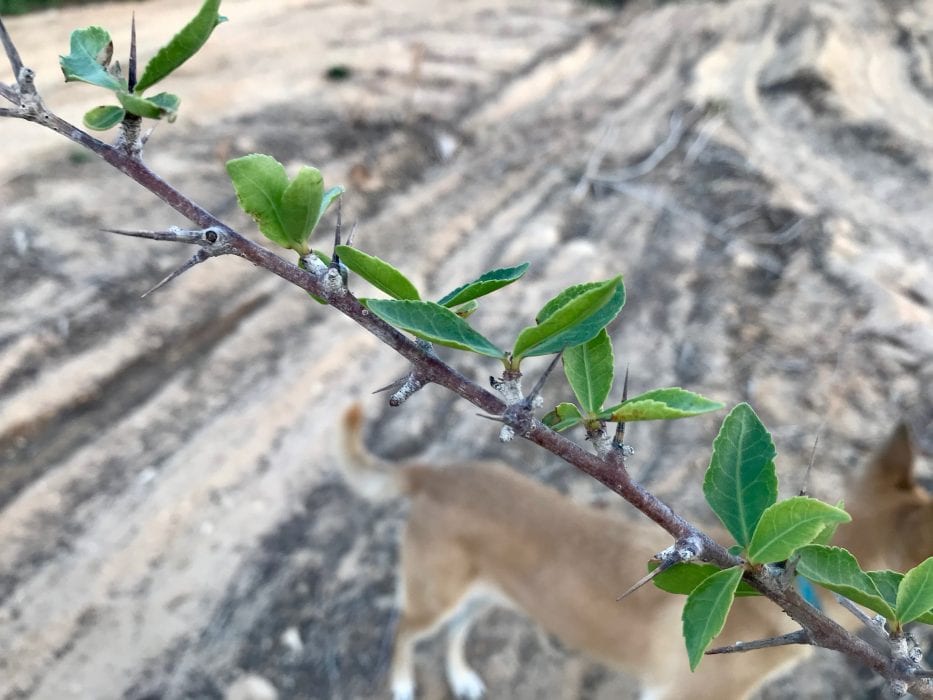CSA STAFF
DR. OREN HOFFMAN
Director
oren@arava.org
NOAH MARTHINSEN Research Manager noah@arava.org
DR. ELAINE SOLOWEY
Researcher emerita
elaine.solowey@arava.org

A few species of incense trees were studied in The Center to understand medicinal properties and conservation of native species; these species also have strong cultural significance due to their presence in the Bible. A total of twelve incense species were studied, including frankincense (Boswellia sacra), myrrh (Commiphora abyssinica), and Balm of Gilead (Commiphora giladensis). Producing a fragrant resin that can be collected and used as raw or processed incense, these species have been used in ceremony for thousands of years. Apart from two peer-reviewed articles published from these studies, (details below) Dr. Solowey also published an e-book in 2018 called Trees of Fragrance and Mystery.
Peer-Reviewed Articles on Incense Trees:
ABSTRACT: The medicinally and historically significant plant species Boswellia sacra, shown to be effective in addressing numerous illnesses and stabilizing desertification in arid areas, has been noted for having an extremely low germination rate. The low rate of genetic variation among wild stands, which is leading to a possible genetic bottleneck, is exacerbated by the common practice of vegetative propagation through tree cuttings in cultivated stands, which produces clones. Stimulation of seeds to germinate under various conditions at Kibbutz Ketura, Israel was attempted in order to increase genetic variability. Seeds were collected from three source locations and screened via sink tests to identify viable seeds as those that were heavy enough to sink in water. The greatest amount of viable seeds came from a tree in Kibbutz Naot Smadar, which was 400 m above sea level and had a higher germination rate (by a factor of four) than those from trees at elevations much closer to sea level. This conspicuous correlation is discussed as a reason for future research to further understand causes and ways of addressing the extraordinarily low regeneration rate of both wild and cultivated stands.
CITATION:
Swartout, Benjamin T., and Elaine Solowey. “Increasing Boswellia sacra seeds’ germination viability and genetic variability utilizing various methods.” Net Journal of Agricultural Science 6, no. 3 (2018): 29-34.
ABSTRACT
The biblical balm of Gilead (Commiphora gileadensis) was investigated in this study for anticancerous activity against tumor cell lines. The results obtained from ethanol-based extracts and from essential oils indicated that β-caryophyllene (trans-(1R,9S)-8-methylene-4,11,11-trimethylbicyclo[7.2.0]undec-4-ene) is a key component in essential oils extracted from the balm of Gilead. β-Caryophyllene can be found in spice blends, citrus flavors, soaps, detergents, creams, and lotions, as well as in a variety of food and beverage products, and it is known for its anti-inflammatory, local anaesthetic, and antifungal properties. It is also a potent cytotoxic compound over a wide range of cell lines. In the current paper, we found that Commiphora gileadensis stem extracts and essential oil have an antiproliferative proapoptotic effect against tumor cells and not against normal cells. β-caryophyllene caused a potent induction of apoptosis accompanied by DNA ladder and caspase-3 catalytic activity in tumor cell lines. In summary, we showed that C. gileadensis stems contain an apoptosis inducer that acts, in a selective manner, against tumor cell lines and not against normal cells.
CITATION:
Amiel, Eitan, Rivka Ofir, Nativ Dudai, Elaine Soloway, Tatiana Rabinsky, and Shimon Rachmilevitch. “β-Caryophyllene, a compound isolated from the biblical balm of gilead (Commiphora gileadensis), is a selective apoptosis inducer for tumor cell lines.” Evidence-based complementary and alternative medicine (2012).
| Botanical Name | Common Name | Distribution | Ongoing Study | Status in Study | medicinal use | cultural | red list/endangered? |
|---|---|---|---|---|---|---|---|
| Balanites aegypticus | Jericho balm | yes | conservation | perfume, in wine Hypocrites/15th c. extinct locally and in the wild, but still grows in gardens | extinct in the wild | ||
| Commiphora giladensis | Balm of Gilead | North Africa/Turkey/ dry climate/natural grove by Dead Sea/doesn’t like cold | yes | conservation | Beta-carapharyline, herbal treatment for bilharzia | for braising-oil, biblical persimmon | no. 15th c. extinct locally and in the wild, but growing still in gardens |
| Moringa peregrina | Marrah Tree | Middle East- dry places | yes | conservation | Ben oil moisturizer | embalming in Egypt, Moses’ story, commercial crop until 200 years ago | rare |
| Styrax officialis | White Styrax | Lebanon, wet part of Jordan, doesn’t grow easily in Arava | yes | medicinal/conservation | Included in Elaine’s book on Incense Trees | floral scents | no |
| Boswellia sacra | Frankincense, levonah, algum | Coasts of Darfur and Horn of Africa, Yemen, Socrata (island in Indian Ocean)- grows naturally and when tended | yes | medicinal/conservation | Anti-inflammatory; Sap used in modern sports medicine | incense- main incense in temple. In Bible, perhaps arriving from Arab Emirates region. | endangered |
| Boswellia neglecta | — | yes | medicinal/conservation | Much unknown | no (unknown) | ||
| Commiphora abyssinica | Abyssinian myrrh, Yemen myrrh | most dry parts of Africa | yes | medicinal | For skin problems via sap (orally) and oil (on skin) | no | |
| Commiphora africana | African myrrh | South Africa/Botswana | yes | medicinal | no | ||
| Commiphora campestris | corkwood | yes | medicinal | Unknown | |||
| Pistachia atlantica | Terebinth tree | mountainous regions: High Atlas Range, Morocco, Negev Highlands, Lebanon | yes | medicinal/conservation | Used against jericho rose- sand fly | root stalk for nuts which is another species, makes turpentine | no, but considered rare |
| Pistachia congincus | Pistachio khinjuk Stocks | yes | medicinal/conservation | ||||
| Boswellia papifera | Sudanese frankincense | yes | medicinal/conservation |

